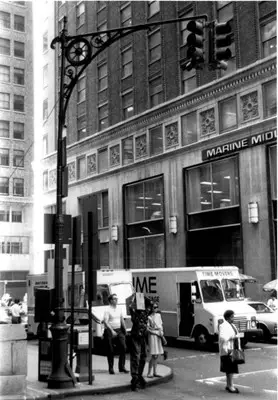COVINGTON, Va. (VR) – The year was 1924. New York City began its first large-scale installation of stoplights to help manage the city’s rapidly expanding auto traffic. Two years earlier, several experimental towers had been constructed on 5th Avenue, supporting human operators who physically controlled the red and green lights. Understandably, these were cumbersome and expensive to operate. The new lights used electrical controls and operated automatically, representing a vast improvement. Two types of iron supports were installed: short, simple olive-green posts that supported a red/green “Ruleta” light, and much larger, more ornate black support posts for use at major intersections.
The larger posts consisted of four sections. A case iron base supported a wrought iron column and tubing. The lateral arm which held the light was also wrought iron, as was its scrollwork. An aluminum wheel representing a 1920s Model T Ford wheel served as an ornament and provided support. When assembled and installed, the stoplight posts were an imposing twenty feet tall.
These posts were produced in Covington, Virginia by the Covington Machine Company, a major industrial operation that shipped iron products around the world. The company’s primary work was producing an array of coal mining and blast furnace equipment including coke loading and extracting machines. The term “coke” referred to a high-carbon fuel derived from coal that provided a much hotter, cleaner burn than raw coal alone. This was crucial for smelting – extracting metal from ore – which required high temperatures and steady heat. The foundry could produce 100,000 pounds of iron castings per day and mold castings weighing 40,000 pounds into a single piece. Company representatives boasted that their machine shops could
build anything in metal from a tin bucket to a locomotive. All the machines and equipment were made in the Covington factories, covering thirteen acres on Lexington Street. The company employed 350 skilled machinists and had sales offices in Australia, Montreal, San Francisco, St. Louis, Chicago, New York, Memphis, Louisville, and New Orleans, and warehouses and a sales office at Uniontown, Pennsylvania. In 1927 the Covington Virginian wrote, “Every civilized country has some product made at Covington by the Covington Machine Company, thus the name of this little city is carried to the uttermost parts of the earth by this well-known concern.”
In 1947, years after the Covington Machine Company had gone out of business, the Covington Virginian interviewed former general manager Edgar Archer, in response to a Saturday Evening Post cover that featured one of the now-classic Covington stoplights. He recalled that New York City had ordered about 11,000 of the big iron light posts – enough to fill thirty-six train carloads.
The first stoplights were installed on Broadway in 1924, and they were soon in use throughout the city. They served faithfully until new guy-wired stoplights replaced them in the 1950s.
By 1994, when New York City’s Landmarks Preservation Commission published a complete inventory of historic streetlamps in the city, only four of the wheel stoplights remained. A few years later Kevin Walsh of the Forgotten New York website took a liking to the classic old light posts, which he dubbed “Wheelies,” and published several articles on their history in the city. He reports that just two original Wheelies remain in New York City today. They cannot be removed because they have been landmarked but no longer serve any purpose except to hold signs.
The Covington Machine Company also delivered iron stoplights and possibly streetlamps to other cities, including Washington, D.C. It is unclear how many of those were Wheelies, or if any still survive. They were only produced during a brief period, as the Covington Machine Company was out of business by 1930 due to unfavorable state tax laws, the failure of the Low Moor Iron Company which provided its raw materials, and the onset of the Great Depression.
In 1927 the Covington Town Council ordered six wheel-themed posts for traffic lights at primary intersections. Tall iron streetlamps were also placed on Main Street; vertical posts with a short arm in the middle to hold the light. A few years later these were extended vertically to hold power lines. All of Covington’s iron streetlight and streetlamp posts were replaced by 1960.
Only four original 1920s iron wheel posts are known to still exist. In addition to the two New York City Wheelies which are damaged and no longer in service, two others survive in neighborhoods just west of Covington. Unlike the posts installed in New York and Covington, these were set up as streetlamps rather than traffic lights. One stands on the driveway of a house near Rosedale built in 1923 by Richard Stokes, a successful Covington attorney who did legal work for the Covington Machine Company. His father-in-law William A. Rinehart was an industrial leader who had been a founding director of the company back in 1891. The placement of the other wheel post, which is located on the Midland Trail at the eastern edge of Westwood Place, is a bit more mysterious since that development only dates back to the early 1930s.
Beginning in 1989, the Covington Revitalization Project Committee began placing aluminum replicas of the iconic wheel posts along West Main Street as streetlamps. These were installed one block at a time during the early 1990s until a total of 28 lamps lined both sides of West Main from the railroad track to North Lexington Avenue. There they remain today, in excellent condition, serving as a lasting memorial to the area’s great iron industry of a century ago.

Original Stoplight in NYC (Landmarks Commission)

Replica Streetlamps today on W. Main St. (Scott Swett)

Iron Streetlamps on W. Main St. (Alleghany Historical Society)

Detail of Design for Replica Streetlamps on W. Main St. (Alleghany Historical Society)

Original Wheel Stoplight at W. Main St. and Monroe Ave. (Alleghany Highlands Genealogical Society)

 The Shadow
The Shadow









